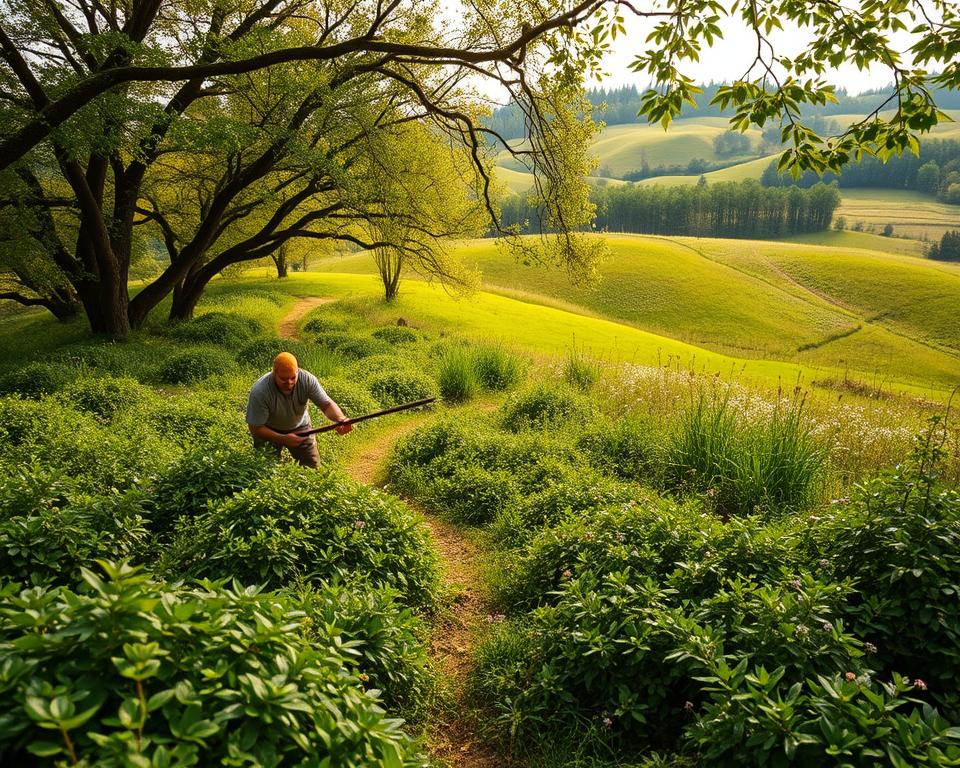Professional Pointers: Forge Trails in Forest Property
Did you know almost 80% of property owners with woodland grounds seldom venture past their yard? This figure underscores the vital need for efficient path opening and upkeep. Opening routes and footpaths in forest areas not only improves reachability but also enhances security and navigation. This article will explore professional methods and perspectives from experienced trail builders.
These professionals will share how to design properly-planned trails that optimize your nature space’s usefulness while preserving its environmental integrity. Discover the primary factors for land clearing and methods for effective wooded grounds maintenance solutions. These can make your experience through your natural environment more delightful.
Important Takeaways
- Comprehending the importance of opening trails for accessibility and security.
- Evaluating site conditions to determine the objective of your paths.
- Utilizing the right tools for efficient trail clearing.
- Choosing appropriate ground materials that match with landform.
- Incorporating eco-friendly methods when opening paths.
- Recognizing common mistakes to avoid during the trail-clearing process.
Why Clearing Trails in Forested Grounds Matters
Maintaining clear routes in wooded zones is vital for several reasons. It significantly improves ease of access, making it easier to navigate dense foliage. This allows landowners and visitors to fully enjoy the environment. It also facilitates various activities like hiking, bird watching, or just relishing the outdoors.
Boosting Access
Clear paths not only enable movement; they also deepen our link with the natural world. By improving approachability, landowners make available the open air to more people. This is useful for personal use or community events, fostering discovery and valorization of the surroundings.
Enhancing Safety and Direction
The significance of security on forest paths is paramount. Marked paths offer straightforward navigation and reduce risks from rough ground, hidden obstacles, or abrupt plant growth shifts. Property owners invest in establishing safe paths, boosting confidence in wilderness exploration.

Planning a Trail in the Woods
Effective trail design demands a thorough understanding of the landscape. It’s about evaluating ground and location factors. Understanding the path’s goal is also crucial, as it shapes construction and maintenance.
Evaluating Terrain and Site Conditions
When evaluating terrain, multiple factors are critical. They include:
- Ground compositions that affect drainage and stability
- Slope degree impacting accessibility and safety
- Current plant life that may require removal or protection
By assessing these factors, trails can withstand various climatic factors. Such routes also accommodate regular pedestrian use. This approach ensures the trail is durable and honors the land’s natural features.
Clarifying Path Intent
Path design success relies on a well-defined purpose. Think about the activities the path will support, such as:
- Recreational walking and nature appreciation
- Access for maintenance or ground management
- Opportunities for wildlife observation and learning
Knowing the path’s goal guides many decisions. This includes the trail’s width and building supplies. Identifying the path’s objective is vital for creating a route that fulfills its requirements.
Tools Needed for Trail Clearing
Effective trail clearing demands the right tools for various tasks. The appropriate tools boost productivity and safety, simplifying the process. The selection between hand tools and motorized equipment depends on the task’s size, terrain, and amount of debris.
Key Manual Instruments
Hand tools are key for accuracy and flexibility in clearing overgrown zones. Essential implements include:
- Loppers: Great for cutting through thick branches and bushes.
- Hand saws: Ideal for precision slicing on trees.
- Digging tools: Handy for digging and creating drainage ditches.
Such instruments provide a hands-on approach, crucial for delicate spots where machinery could damage.
Motorized Tools for Speed
For big path clearing projects, motorized devices are a game-changer. Such equipment make the process speedier and more productive. Crucial equipment include:
- Chainsaws: Excellent for felling big timber and cutting through dense underbrush.
- Brushcutters: Quick for clearing dense turf and smaller saplings.
Power equipment reduces opening duration, making it suitable for extensive zones. Safe operation is imperative to avoid injuries.
Strategies for Clearing Paths and Trails in Wooded Property
Opening routes and trails in wooded areas requires careful planning. It is essential to mediate practicality with sustainability. Effective vegetation management maintains the natural ecosystem’s harmony while establishing useful routes. This equilibrium is crucial to a positive exterior encounter.
Removing Excess Growth
Selective clearing techniques are vital when tackling overgrowth. Hand tools allow for precise removal of unwanted vegetation without harming the ecosystem. Such approach encourages the flourishing of desired plants while restraining foreign species. Ongoing maintenance stops regrowth, improving trail security and accessibility.
Designing Eco-Friendly Trails
A sustainable path design is more than aesthetic; it includes choosing materials that minimize soil loss and improve drainage. These methods honor the environment and lessen environmental harm. Employing native stones or reclaimed wood bolsters durable durability and ecological harmony. Careful planning achieves a equilibrium between usability and environmental preservation.
Trail Surface Options: Finding the Right Fit
Selecting the appropriate trail surface is vital for both functionality and durability. The choice between organic and man-made coverings affects upkeep, comfort, and path lifespan. Understanding the various options and their suitability for your ground is crucial to establishing an optimal path.
Organic versus Synthetic Trail Covers
Natural surfaces, such as gravel, broken rock, or mulch, are often more affordable. They integrate well with the surroundings, facilitating water flow and a natural look. In contrast, man-made surfaces like concrete pavers are more durable and suitable for intensive traffic. Every option has its advantages and drawbacks, based on the planned application and climate factors.
Choosing the Right Materials for Your Terrain
Selecting the right materials involves considering soil type, drainage needs, and cost constraints. Here’s a basic guide to popular options:
| Material | Advantages | Disadvantages | Cost per Square Foot |
|---|---|---|---|
| Gravel | Affordable, Good drainage | Requires regular top-up | $1 – $3 |
| Crushed Stone | Steady footing, Organic appearance | Potentially slippery when wet | $2 – $5 |
| Wood Chips | Eco-friendly, Soft underfoot | Needs frequent topping up | $1 – $2 |
| Concrete Pavers | Durable, Low maintenance | More expensive initially | $5 – $15 |
Carefully choosing ground coverings guarantees your routes are functional and enhance the site’s scenic appeal.
Building Bridges and Turnpikes
Establishing paths in wooded areas requires thoughtful planning of elevation changes. This is crucial for smooth transitions across different terrains and ensuring trail usability over time. Constructing overpasses for trails is often necessary, mainly when crossing wet areas or natural depressions.
Identifying When to Add Height Variations
Elevation in path design is often due to irregular ground. Major drops or rises necessitate builds like bridges or turnpikes to maintain trail soundness. This approach helps prevent soil erosion and ensures security, vital for both leisure walkers and avid nature lovers.
Choosing Bridge Materials for Marshy Terrain
The choice of materials for elevated walkways and overpasses is critical for their safety and durability. Logs, concrete blocks, or preservative-treated wood can offer the required support against weight and weather conditions. It’s crucial to select materials that are water-resistant to prevent degradation and allow subsequent modifications.
Trail Maintenance and Upkeep
Keeping trails safe and accessible requires continuous care. Regular inspections assist in spotting problems early, making sure visitors have a good experience. It’s vital to upkeep paths seasonally, as climatic shifts can damage them. This part will discuss a comprehensive maintenance checklist and the advantages of employing expert path care solutions.
Seasonal Maintenance Checklist
A thorough checklist helps trail owners maintain their trails in prime condition all year. Important tasks include:
- Removing debris such as fallen branches and leaves.
- Inspecting trail surfaces for damage, after storms.
- Checking water channels to prevent water buildup.
- Repairing erosion by supplementing material as required.
- Updating markers and markers for straightforward direction.
Expert Path Care Providers
For those requiring expert help, professional trail maintenance services are a excellent choice. They provide:
- Comprehensive trail assessments by experienced experts.
- Advanced repairs and rehabilitation of high-traffic paths.
- Employing dedicated equipment for better surface care.
- Implementing sustainable practices to extend trail life.
Engaging expert trail maintenance frees up your time for other activities. It also introduces expert knowledge.
Landscaping Surrounding Paths
Garden design is crucial to rendering paths visually appealing. By thoughtfully choosing plants and elements, you can craft an inviting environment. This not only attracts visitors but also supports local ecosystems. The right vegetation for paths add beauty and sustain environmental stability.
Adding Plants for Attractiveness
When designing trail landscaping, selecting the right plants is critical. Native plants are ideal as they organically blend with the surroundings. They need less maintenance and offer habitat for local fauna. Combine blooming flora, bushes, and turf for a diverse, appealing ambiance around paths.
Using Stones and Edging Materials
Border supplies like rocks and pavers are vital for trail structure. They define the path and contribute to its design. These materials stop soil erosion and provide a neat contrast with plants. Using varied textures and colors can render the trail more engaging.
Eco-Friendly Path Preparation
Path opening tasks should prioritize eco-consciousness. Sustainable land management practices help protect the area’s ecological integrity. This approach makes sure trails coexist with the natural world harmoniously.
Eco-Friendly Clearing Methods
Adopting sustainable practices in trail clearing is essential. Minimal-impact methods reduce land degradation and protect ecosystems. Targeted removal and eco-friendly supplies minimize land disturbance.
Learning the terrain and plant life is key. It supports ethical land management and improves path usability.
Impact on Local Wildlife and Flora
Wildlife impact assessments are vital in trail development. They assist gauge the task’s impact on local animals and plants. This permits for necessary adjustments before building begins.
Spotting critical habitats avoids environment disruption. This balance ensures a healthy environment for every form of life.
Path constructors can create eco-friendly routes with thoughtful planning. This focus to environmental sustainability and fauna protection improves nature engagement. It reconciles leisure pursuits with eco-protection.
Pitfalls to Avoid in Path Opening
Engaging in trail opening requires steering clear of frequent pitfalls to prevent long-term problems. Recognizing these mistakes allows for improved preparation and implementation. By focusing on straightforward path layout and managing water flow, one can avoid costly upkeep demands.
Overengineering Trail Layouts
Trail design often succumbs to the pitfall of over-complicating trail design. Many users think complex designs make paths more appealing. Yet, simplicity is often the secret to effectiveness. Straightforward routes enhance wayfinding and upkeep, minimizing hurdles.
Unnecessary twists and intricate features can lead to path mistakes. These problems hinder usage and navigation, making trails less enjoyable.
Ignoring Drainage Needs
Neglecting drainage challenges in trails can have serious consequences. Adequate drainage planning avoids logging, which can wash out paths and harm grounds. Adequate drainage solutions are essential for a durable path.
Ensuring water flows away from the path safeguards the pathway and protects the ecosystem. This allows for a more pleasant outdoor experience.
Final Thoughts
Path clearing is essential for those who wish to completely enjoy their forest properties. It improves ease of access and safety, making outdoor spaces pleasant for all. Forest paths offer more than mere scenic appeal; they provide chances for recreation and education about the environment.
Effective planning and execution are crucial in path clearing. Evaluating ground and choosing the proper materials are essential for establishing lasting routes. Regular upkeep keeps these paths safe and accessible, fostering a ongoing connection with nature.
By grasping the concepts discussed above, you can plan and maintain paths that fulfill both functional and leisure needs. Embracing forest trails can turn your grounds into a haven for exploration, rest, and valuing nature.
